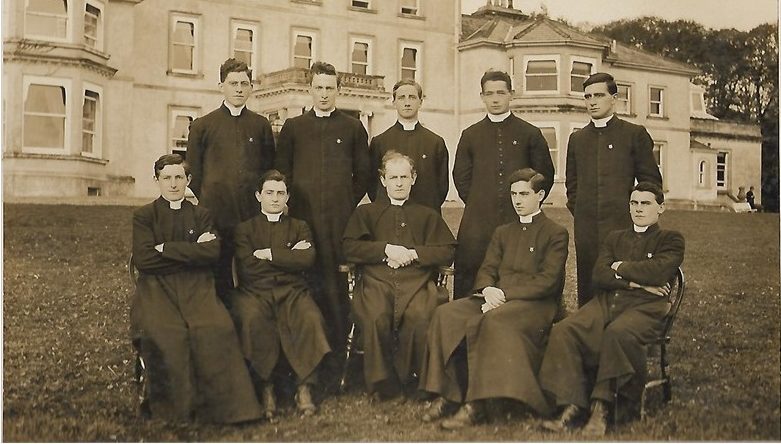The Meath Archaeological & Historical Society invited Fr Neil Collins to address them to mark the Society’s Centenary. On Sunday 18 November, Fr Collins gave the following lecture titled:
‘The Columban Odyssey from Dalgan to the Far East – Centenary of the Columban Fathers’
The Columban Odyssey. Perhaps we should have named this talk ‘The Columban Pilgrimage’. Odysseus seems to have wandered without direction. Pilgrims are led by a kindly light. It’s hard to miss the finger of God in the beginnings of the Columbans. We can go back to the end of June 1911 in St. Patrick’s College, Maynooth.
 [2] The students were packing, looking forward to going home next day. An unexpected bell called them to the Aula Maxima to listen to a Canadian missionary, John Fraser, [3] about his mission in China. Among his audience were John Blowick, Joseph O’Leary, Edward J. McCarthy and James Conway. Blowick wrote,
[2] The students were packing, looking forward to going home next day. An unexpected bell called them to the Aula Maxima to listen to a Canadian missionary, John Fraser, [3] about his mission in China. Among his audience were John Blowick, Joseph O’Leary, Edward J. McCarthy and James Conway. Blowick wrote,
‘He forced us to realise that China was a pagan nation, that priests were so few as to be practically powerless in their efforts to cope with the enormous task they had set themselves – the Catholicising of China.’[i]
 After his ordination on the 22 June 1913 for the Archdiocese of Tuam Blowick continued his studies in the Dunboyne Establishment until he became a professor of dogmatic theology in a competitive concursus in 1914. The topic assigned for his first year’s lectures was De Ecclesia and he remembered that
After his ordination on the 22 June 1913 for the Archdiocese of Tuam Blowick continued his studies in the Dunboyne Establishment until he became a professor of dogmatic theology in a competitive concursus in 1914. The topic assigned for his first year’s lectures was De Ecclesia and he remembered that
‘when teaching the doctrine of the Catholicity of the Church and the genius for expansibility which her divine founder has implanted in her I felt an extraordinarily great hypocrite, prating about all this, believing it, and doing as little as I could to put it into practice’.[ii]
 Meanwhile the finger of God had been writing on the other side of the Atlantic. Edward Galvin [4], a young priest of Cork diocese on loan to Brooklyn, was thinking of going as a missionary.[iii] It was his day off in January 1912 and he was planning to visit the Society for the Propagation of the Faith in Manhattan for advice when two sick calls prevented him. Instead he went to lunch and met a visitor, John Fraser, who ignored him and talked to the parish priest about China. After the meal Galvin volunteered to go to China.[iv] He wrote to his mother [5]
Meanwhile the finger of God had been writing on the other side of the Atlantic. Edward Galvin [4], a young priest of Cork diocese on loan to Brooklyn, was thinking of going as a missionary.[iii] It was his day off in January 1912 and he was planning to visit the Society for the Propagation of the Faith in Manhattan for advice when two sick calls prevented him. Instead he went to lunch and met a visitor, John Fraser, who ignored him and talked to the parish priest about China. After the meal Galvin volunteered to go to China.[iv] He wrote to his mother [5]
 Fraser brought him to the province of Hangzhou where he was almost overwhelmed by the task. He began a series of long letters home looking for priests to join him.
Fraser brought him to the province of Hangzhou where he was almost overwhelmed by the task. He began a series of long letters home looking for priests to join him.
[6] ‘Our vicariate is almost as large as Ireland and we have only 20 missionary priests. The pagan population is 11 million’.[v]
Two men, Joe O’Leary of Cork and Pat O’Reilly of Meath, arrived at the end of 1915. They persuaded him to go home ‘to start a Chinese mission college in Ireland for an Irish vicariate’. [vi]
 He reached Cork at the end of August 1916 and visited his bishop, Dr. Daniel Cohalan who was so impressed by the sad state of the Church in China that he gave him an enthusiastic letter to Cardinal Michael Logue, Archbishop of Armagh.[vii]
He reached Cork at the end of August 1916 and visited his bishop, Dr. Daniel Cohalan who was so impressed by the sad state of the Church in China that he gave him an enthusiastic letter to Cardinal Michael Logue, Archbishop of Armagh.[vii]
On 4 September Galvin went to 16 Longford Terrace, Monkstown, where he met John Blowick for the first time.[7] They discussed the plan and two days later Blowick decided to resign his chair in Maynooth and lead the project.[viii]
 Galvin’s next engagement was with the Cardinal in Armagh.[8] His brief letter to O’Leary about their meeting is almost telegraphic with excitement,
Galvin’s next engagement was with the Cardinal in Armagh.[8] His brief letter to O’Leary about their meeting is almost telegraphic with excitement,
‘Saw Mickey [the cardinal]. Said good work. Suggested a committee of representative priests be formed.’[ix]
The committee gathered on 2 October and drew up a memorial to present to the Irish bishops who met on 10 October 1916. They asked
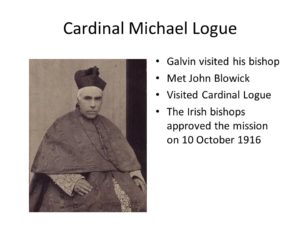 ‘… for the approval and blessing of the Bishops on the project of establishing a Mission House or College in Ireland for the training of Irish priests who are prepared to devote their lives to the propagation of the Catholic Faith in China.
‘… for the approval and blessing of the Bishops on the project of establishing a Mission House or College in Ireland for the training of Irish priests who are prepared to devote their lives to the propagation of the Catholic Faith in China.
[9] ‘… The Bishops, having given careful consideration to this important memorial, joyfully approve and bless the project and earnestly commend to the generous help and support of the faithful the establishment of this Mission House for the training of Irish missionaries for China….’[x]
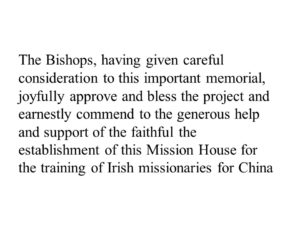 Once they had the approval of the bishops Blowick and Galvin, joined by John Henaghan, E.J. McCarthy, and James Conway, began to campaign the length and breadth of Ireland for the money they’d need. Well known Dominican preachers, Blowick’s colleagues from Maynooth, and bishops and priests in practically every diocese added their voices. By 12 June 1917 Blowick reported to the bishops that they had eighteen thousand pounds and some hundreds.[xi]
Once they had the approval of the bishops Blowick and Galvin, joined by John Henaghan, E.J. McCarthy, and James Conway, began to campaign the length and breadth of Ireland for the money they’d need. Well known Dominican preachers, Blowick’s colleagues from Maynooth, and bishops and priests in practically every diocese added their voices. By 12 June 1917 Blowick reported to the bishops that they had eighteen thousand pounds and some hundreds.[xi]
A telegram from the Rector of the Irish College in Rome, Mgr Michael O’Riordan, reached Blowick on 3 May 1917 and shocked him. It read, ‘Come out and come quickly’. Due to the war, he and Galvin had difficulty in getting travel documents and train tickets, but they reached Rome and were received by the Secretary of the Congregation for the Propagation of the Faith (Propaganda) with the greeting, ‘Bolscevici’. Someone had put out a rumour that
‘… we weren’t genuine missionaries at all. We were a bunch of Sinn Féiners who were providing a decent front for priests who didn’t want to go into the army.’
The story was brought to the Prefect of the Congregation, Cardinal Domenico Serafini, and threatened to block the approval of the new mission. However with the help of O’Riordan and letters signed by Cardinal Logue the two young priests convinced Propaganda that the undertaking was real. Serafini gave them a letter welcoming the founding in Ireland of a college for the Foreign Missions.[xii]
Returning to Ireland they searched for a house that would be suitable for a mission headquarters and seminary.
‘So Galvin and myself started hunting around during that July, August, and September – scurrying around the country, north, south, east and west.’
The committee who presented the memorial to the bishops in October mentioned that there were two or three suitable houses in Terenure, but that suggestion was vetoed by the Archbishop of Dublin, Michael Walsh. A Monsignor Ryan offered a place called Cabragh Castle near Thurles. However there were onerous conditions. The owners of Stackallen ‘wouldn’t have anything to do with us’. Finally in Fr. Denis O’Hara told Blowick of
 ‘… a beautiful house and about two hundred acres of land at Dalgan Park [10] – and he was quite sure that we could get it from the Congested Districts Board at a reasonable figure.’
‘… a beautiful house and about two hundred acres of land at Dalgan Park [10] – and he was quite sure that we could get it from the Congested Districts Board at a reasonable figure.’
Dalgan Park was built in 1801 by a Major Kirwan. His ambition was to create the biggest house in Connaught, in competition with the Earl of Sligo, and he wagered half his annual rental on the project. He won the bet but it cost him a fortune that he never recovered.[xiii] In 1853 the entire estate was sold in the Encumbered Estates’ Court for £48,300. The buyer was the Duke of Bedford acting on behalf of Lady de Clifford, the wife of his first cousin.[xiv] Her descendant, Lord de Clifford, held many dances and concerts in the magnificent ballroom. However in 1910 during a recital part of the balcony crashed into the hall, seriously injuring many of the guests. A few days later the Lord quit Dalgan Park forever. The property passed into the hands of the Congested Districts Board.
Alerted by Fr. O’Hara, Blowick turned to the Bishop of Raphoe, Patrick O’Donnell, who happened to be in Dublin. The bishop took his silk hat and walked across Rutland (now Parnell) Square to the offices of the board and came back with the whole thing settled. The rent was two hundred a year with the option of purchasing it.
 Blowick spent three weeks practically living in Arnott’s, buying everything from furniture to salt spoons to coal.
Blowick spent three weeks practically living in Arnott’s, buying everything from furniture to salt spoons to coal.
Finally the house was ready and on 29 January 1918 the first eighteen students moved in – the nineteenth, Seamus O’Rourke, a teacher, had to serve out until the end of March.
 All, priests and students,[11] had to share rooms, except Fr. Cornelius Tierney.
All, priests and students,[11] had to share rooms, except Fr. Cornelius Tierney.
Since he, at 46, was much older than the rest they gave him his own room.
First Students 1918 [12]
| Class | Name | Diocese | Came From |
| IV Theology | Alphonsus Ferguson | Derry | Maynooth |
| III Theology | Joe Mullen | Tuam | Maynooth |
| John O’Donovan | Ross | Maynooth | |
| Alphonsus Kerr | Down & Connor | Maynooth | |
| Billy Flynn | Cork | Maynooth | |
| II Theology | Thomas Quinlan | Cashel | Thurles |
| Larry Forrestal | Ossory | Maynooth | |
| Jack O’Brien | Cork | Maynooth | |
| Art McGuinness | Cork | Carlow | |
| I Theology | Charlie Cullen | Derry | Maynooth |
| Bob Galvin | Cloyne | Kilkenny | |
| Bart Coveney | Cork | Maynooth | |
| Dan Carey | All Hallows | ||
| I Philosophy | Frank Murray | Clonfert | Maynooth |
| Jack O’Carroll | Kilmore | Carlow | |
| Bill Murphy | Cork | Carlow | |
| George Hendrick | Limerick | Carlow | |
| Michael Dunne | Cork | Carlow | |
| Seamus O’Rourke | came later |
 [14] The German Spring Offensive in 1918 put such severe strain on the allied armies that Lloyd George, the British prime minister, decided to extend conscription to Ireland. John Blowick went to Maynooth where the bishops were meeting on Thursday, 18 April 1918, to get permission to buy Dalgan.
[14] The German Spring Offensive in 1918 put such severe strain on the allied armies that Lloyd George, the British prime minister, decided to extend conscription to Ireland. John Blowick went to Maynooth where the bishops were meeting on Thursday, 18 April 1918, to get permission to buy Dalgan.
The bishops were considering the question of conscription and Blowick found that they were going to hold ordinations on 28 April. He decided to have Columban students ordained too, first divines to sub-diaconate, seconds to diaconate, thirds and fourths to priesthood – all on the morning of Sunday, 28 April. Alphonsus Ferguson, Joe Mullen, John O’Donovan, Alphonsus Kerr and Billy Flynn became priests.
By the end of the summer term 1920 there were 41 students and 7 priests. The house was over-crowded. Plans for a new college in Shrule were shelved.
Patrick Cleary, Rector in Dalgan Park, drew Blowick’s attention to Cahercon. [15]
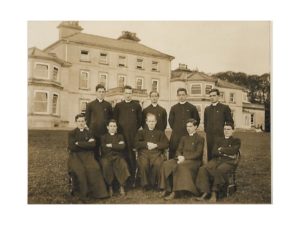 He wrote to Michael O’Dwyer, ‘We want you…. We have just purchased a magnificent new house and place called Cahercon in Co. Clare.’[xv]
He wrote to Michael O’Dwyer, ‘We want you…. We have just purchased a magnificent new house and place called Cahercon in Co. Clare.’[xv]
It belonged to the Vandeleur family, landlords of Dutch descent..[xvi] The society bought the property for £14,000 and named it St. Senan’s Philosophical College.
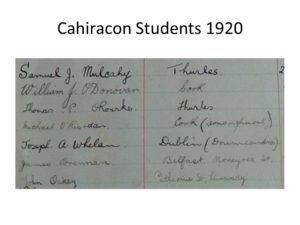 Seven students [16] who had completed First Philosophy in Dalgan Park entered St. Senan’s on 31 August 1920.[xvii]
Seven students [16] who had completed First Philosophy in Dalgan Park entered St. Senan’s on 31 August 1920.[xvii]
John Blowick remembered, ‘Still the idea of getting a more central site was in every one’s mind but, to be candid, it seemed only a foolish dream. We had a big overdraft at the bank caused chiefly I think by the colossal sums spent in opening and outfitting Hanyang.’
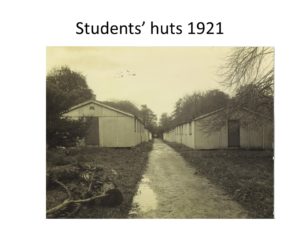 Accomodation in Dalgan was eased by the erection of huts. [17] A student wrote, ‘It was left to each to choose either the House or the Huts, a share in the massive grey building that is the kernel of Dalgan or a billet in the suburbs, the red-roofed, one-storeyed greater Dalgan.’[xviii]
Accomodation in Dalgan was eased by the erection of huts. [17] A student wrote, ‘It was left to each to choose either the House or the Huts, a share in the massive grey building that is the kernel of Dalgan or a billet in the suburbs, the red-roofed, one-storeyed greater Dalgan.’[xviii]
[18] Blowick attempted to keep the Society’s finances under control, even sailing to New York in 1922 to meet Galvin and McCarthy.
Negotiations for the purchase of a property convenient to Dublin began in 1923. On 23 March the society solicitor, John J. McDonald, sent a telegram to Blowick,
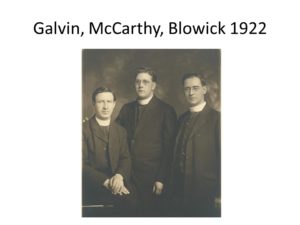 ‘Some time ago you asked me to look out for some place that might suit your requirements in County Meath, or Westmeath. I was speaking to Mr. Willis, through whom you purchased Cahircon, and he mentioned a suitable place named Dowdstown three miles from Navan.’
‘Some time ago you asked me to look out for some place that might suit your requirements in County Meath, or Westmeath. I was speaking to Mr. Willis, through whom you purchased Cahircon, and he mentioned a suitable place named Dowdstown three miles from Navan.’
No immediate action was taken. The Society had been expanding too rapidly, buying property and erecting buildings in Ireland, America, Australia, and China. A general chapter in June 1924 chose a new general general, Michael O’Dwyer, to replace Blowick, and recommended that ‘he should endeavour with all his strength to put the finances of the Society on a solid foundation’
 However during Holy Week 1926 Blowick and James Kennedy visited Laurence Gaughran, Bishop of Meath. The bishop ‘grew lyrical’ about Dowdstown. [19]
However during Holy Week 1926 Blowick and James Kennedy visited Laurence Gaughran, Bishop of Meath. The bishop ‘grew lyrical’ about Dowdstown. [19]
Blowick remembered, ‘We began sounding Father MacPolin the Oec. Gen. [Bursar General] about doing something about Dowdstown. No good. He was nursing his overdraft and told us to have sense.
April 14th 1926 – Wednesday – arrives a letter from Messrs Cartan, O’Meara, Cussen & Kieran solrs Dublin. Out of the letter fell a cheque which was, as Fr. Joe Whelan said when he saw it, ‘Paved with noughts’. The letter ran:
Dear Rev. Sir,
By direction of Mr Patrick Byrne of 19 Zion Road, Rathgar, Dublin we send you a cheque for £2,000 to be applied for the purpose of the Mission to China. Kindly own receipt. Mr. Byrne does not wish any publicity given to the donation but trusts he will be remembered in the prayers of the missionaries and of this Congregation.
Yours faithfully …..
This letter was dated 12th April 1926 and when Fr MacPolin saw it he was completely staggered and said something to the effect that it would not be right to ignore such a sign from God. The result (if I remember aright) was that he went to Dublin, saw the bank people and agreed to stabilize the overdraft at (I think) £7,000 on which we would continue to pay interest while collecting for the purchase of Dowdstown.[xix]
 On 10 November 1926 Michael O’Dwyer wrote to E. J. McCarthy, [20]
On 10 November 1926 Michael O’Dwyer wrote to E. J. McCarthy, [20]
‘We have bought a place near Navan for £15,250.0.0. Yesterday morning I got word that the vendors had accepted the offer. It is an hour from Dublin by rail and road, and there is a public bus passing the door. We are trying to sell Cahiracon to the Land Commission. The place will house headquarters and regional staff for the present…. The Colleges will be amalgamated in Dalgan for the present.’
The Far East Office was built 1928/9.
Blowick began to appeal to the readers of The Far East for money to build a new College in Dowdstown. In a letter dated 20 February 1929 he explained,
‘The main building in Dalgan is sufficient to accommodate only the priests and sisters and to provide a few class-rooms and the dining room. All the students are living in two workmen’s houses in the farmyard and a number of wooden huts. Today, Dalgan is called upon to provide accommodation for 133 people – 83 students, 12 priests, 5 sisters and 13 brothers. Their quarters are flimsy, cold and unsatisfactory.[xx]
 Appeals continued. [21] It was only in the summer of 1937 that work could begin. Cardinal Joseph MacRory blessed the corner stone on Sunday, 18 September 1938. The new college opened in 1941. Two years later, on 22 November 1943 the chapel was consecrated.
Appeals continued. [21] It was only in the summer of 1937 that work could begin. Cardinal Joseph MacRory blessed the corner stone on Sunday, 18 September 1938. The new college opened in 1941. Two years later, on 22 November 1943 the chapel was consecrated.
Now as we come to the end of our celebrations for the Centenary of the Society we remember some of the accidents and coincidences that led our founders from Mayo to China and here to Co. Meath. Were they accidents? Were they coincidences? Or were they gifts from the God of Surprises? Maybe he has more surprises in store.
References:
[i] John Blowick, ‘The Maynooth Mission to China’ in The Catholic Truth Annual (Dublin, 1917), p. 42.
[ii] John Blowick, Shorter Notes.
[iii] Edward J. Galvin to Mary Galvin, 27 Oct. 1912.
[iv] Edward J. Galvin to Mary Galvin, 28 Feb. 1912.
[v] Edward J. Galvin to a priest in Maynooth, 20 July 1913.
[vi] Edward J. McCarthy to Joseph O’Leary, 9 Apr. 1916.
[vii] Edward J. Galvin to Joseph O’Leary, 26 Aug. 1916.
[viii] Edward J. Galvin to Joseph O’Leary, 6 Sept. 1916.
[ix] Edward J. Galvin to Joseph O’Leary, 8 Sept. 1916.
[x] Irish Times, 11 Oct. 1916.
[xi] John Blowick, Informal Talks to Probationers, 1968.
[xii] Congregation for the Propagation of the Faith to Michael Logue, 18 July 1917.
[xiii] The Story of an Old Estate, in The Far East (Australian Edition), Dec 1920, pp 3-6.
[xiv] Dalgan Park Estate.
[xv] Patrick Cleary to Michael O’Dwyer, 21 Jan. 1920.
[xvi] John Blowick, Brief note regarding the acquisition of the Dalgan property, 29 Oct. 1957
[xvii] Maynooth Mission to China, Register of Students in St. Senan’s College.
[xviii] Students’ Notes, in The Far East (Jan 1922), p. 11.
[xix] John Blowick, Brief note, 29 Oct. 1957.
[xx] John Blowick, Our Next Need, in TFE Mar. 1929, p. 60.

